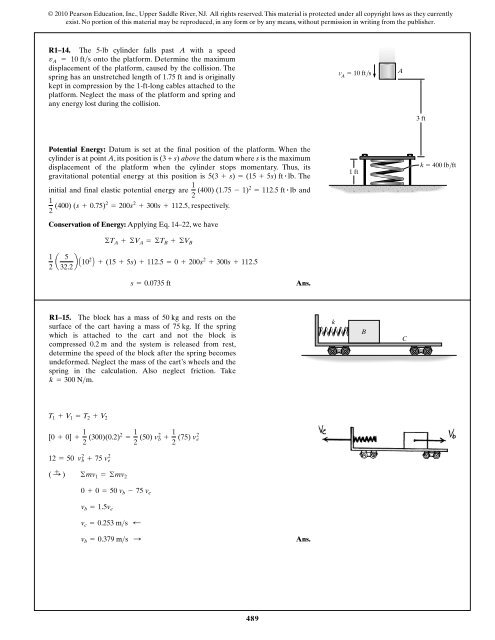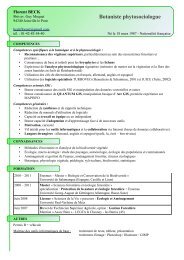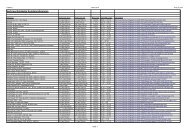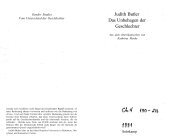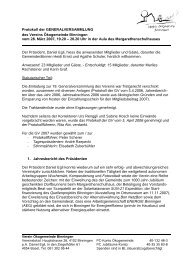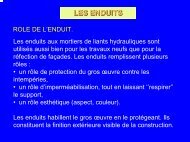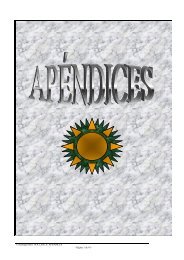479 Horizontal Motion: The horizontal component of velocity ... - Wuala
479 Horizontal Motion: The horizontal component of velocity ... - Wuala
479 Horizontal Motion: The horizontal component of velocity ... - Wuala
You also want an ePaper? Increase the reach of your titles
YUMPU automatically turns print PDFs into web optimized ePapers that Google loves.
91962_05_R1_p0<strong>479</strong>-0512 6/5/09 3:53 PM Page 489<br />
© 2010 Pearson Education, Inc., Upper Saddle River, NJ. All rights reserved. This material is protected under all copyright laws as they currently<br />
exist. No portion <strong>of</strong> this material may be reproduced, in any form or by any means, without permission in writing from the publisher.<br />
R1–14. <strong>The</strong> 5-lb cylinder falls past A with a speed<br />
v A = 10 ft>s onto the platform. Determine the maximum<br />
displacement <strong>of</strong> the platform, caused by the collision. <strong>The</strong><br />
spring has an unstretched length <strong>of</strong> 1.75 ft and is originally<br />
kept in compression by the 1-ft-long cables attached to the<br />
platform. Neglect the mass <strong>of</strong> the platform and spring and<br />
any energy lost during the collision.<br />
v A 10 ft/s<br />
A<br />
3 ft<br />
Potential Energy: Datum is set at the final position <strong>of</strong> the platform. When the<br />
cylinder is at point A, its position is (3 + s) above the datum where s is the maximum<br />
displacement <strong>of</strong> the platform when the cylinder stops momentary. Thus, its<br />
gravitational potential energy at this position is 5(3 + s) = (15 + 5s) ft # lb . <strong>The</strong><br />
1<br />
and<br />
2 (400) (1.75 - 1)2 = 112.5 ft # lb<br />
initial and final elastic potential energy are<br />
1<br />
, respectively.<br />
2 (400) (s + 0.75)2 = 200s 2 + 300s + 112.5<br />
Conservation <strong>of</strong> Energy: Applying Eq. 14–22, we have<br />
1 ft<br />
k 400 lb/ft<br />
©T A +©V A =©T B +©V B<br />
1<br />
2 a 5<br />
32.2 b A102 B + (15 + 5s) + 112.5 = 0 + 200s 2 + 300s + 112.5<br />
s = 0.0735 ft<br />
Ans.<br />
R1–15. <strong>The</strong> block has a mass <strong>of</strong> 50 kg and rests on the<br />
surface <strong>of</strong> the cart having a mass <strong>of</strong> 75 kg. If the spring<br />
which is attached to the cart and not the block is<br />
compressed 0.2 m and the system is released from rest,<br />
determine the speed <strong>of</strong> the block after the spring becomes<br />
undeformed. Neglect the mass <strong>of</strong> the cart’s wheels and the<br />
spring in the calculation. Also neglect friction. Take<br />
k = 300 N>m.<br />
k<br />
B<br />
C<br />
T 1 + V 1 = T 2 + V 2<br />
[0 + 0] + 1 2 (300)(0.2)2 = 1 2 (50) v2 b + 1 2 (75) v2 e<br />
12 = 50 v 2 b + 75 v 2 e<br />
( : + ) ©mv 1 =©mv 2<br />
0 + 0 = 50 v b - 75 v e<br />
v b = 1.5v e<br />
v c = 0.253 m>s ;<br />
v b = 0.379 m>s :<br />
Ans.<br />
489


